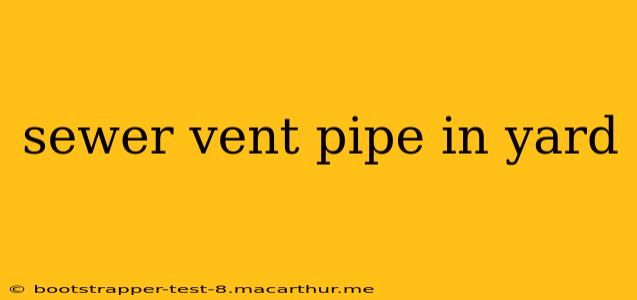Seeing a pipe sticking up from your yard can be unsettling, especially if you don't know what it is. That pipe, if connected to your sewer system, is likely a sewer vent pipe, and understanding its function is crucial for maintaining a healthy and functional plumbing system. This comprehensive guide explains everything you need to know about sewer vent pipes in your yard, addressing common concerns and offering solutions to potential issues.
What is a Sewer Vent Pipe?
A sewer vent pipe, also known as a vent stack or soil stack vent, is a crucial component of your home's plumbing system. Its primary function is to allow sewer gases to escape outdoors, preventing them from backing up into your home. These gases, which are a byproduct of wastewater decomposition, can be unpleasant, and in some cases, even hazardous to your health. The vent pipe creates a balanced pressure within the drain system, ensuring proper drainage and preventing siphoning, which can lead to slow drains and clogs. It's essentially a safety valve for your entire sewage system.
Why is my sewer vent pipe in the yard?
Often, sewer vent pipes are located in the yard for several practical reasons:
- Accessibility: Positioning the vent pipe in the yard provides easier access for inspections and maintenance. Repairing or replacing a vent pipe located on the roof can be significantly more complicated and expensive.
- Aesthetics: While not always the case, placing the vent pipe in the yard often allows for a cleaner and less obtrusive appearance compared to having it on the roof.
- Building Codes: Local building codes may dictate the placement of sewer vent pipes, often prioritizing safety and ease of access.
How do I know if it's a sewer vent pipe?
A sewer vent pipe typically features a cap or screen at the top to prevent debris and animals from entering. It's usually made of PVC or similar durable material and might be slightly wider in diameter than other pipes in the yard. If you're unsure, it's always best to consult a qualified plumber.
What happens if my sewer vent pipe is clogged or damaged?
A clogged or damaged sewer vent pipe can cause several significant problems:
- Slow Drains: The most common issue is slow draining sinks, tubs, and toilets. Without proper ventilation, the pressure in the drainage system becomes unbalanced, hindering the flow of wastewater.
- Gurgling Drains: You might hear gurgling sounds coming from your drains as air struggles to escape.
- Sewer Gas Odors: The most unpleasant symptom is the presence of sewer gas odors inside your home. These gases can be harmful to your health and create an uncomfortable living environment.
- Sewage Backup: In severe cases, a completely blocked vent can cause sewage to back up into your home through drains and toilets. This is a serious issue requiring immediate professional attention.
How do I maintain my sewer vent pipe?
Regular maintenance can prevent many problems associated with sewer vent pipes:
- Regular Inspections: Visually inspect the vent pipe regularly for any signs of damage, cracks, or blockages.
- Professional Cleaning: If you suspect a blockage, it's best to call a qualified plumber to clear the vent using specialized equipment. Attempting to clear it yourself might worsen the problem.
- Avoid Obstructions: Keep the area around the vent pipe clear of debris and vegetation to prevent blockages.
Can I remove my sewer vent pipe?
No, you should never attempt to remove your sewer vent pipe. It is a critical component of your plumbing system and removing it will severely compromise the functionality and safety of your drainage system. Removing it could lead to serious plumbing problems and health hazards.
What if my sewer vent pipe is leaking?
A leaking sewer vent pipe is a serious issue that should be addressed immediately by a professional plumber. Leaks can cause damage to your yard and potentially lead to further problems with your sewer system.
Is there a way to disguise my sewer vent pipe?
You can try various methods to aesthetically improve the appearance of your sewer vent pipe, such as landscaping around it, using a decorative cover, or incorporating it into a garden feature. However, ensure that these methods do not impede the pipe's functionality or create blockages.
This guide provides a comprehensive overview of sewer vent pipes in your yard. Remember, if you encounter any issues with your sewer vent pipe, it's crucial to consult a licensed and experienced plumber. Ignoring problems can lead to costly repairs and health hazards.
